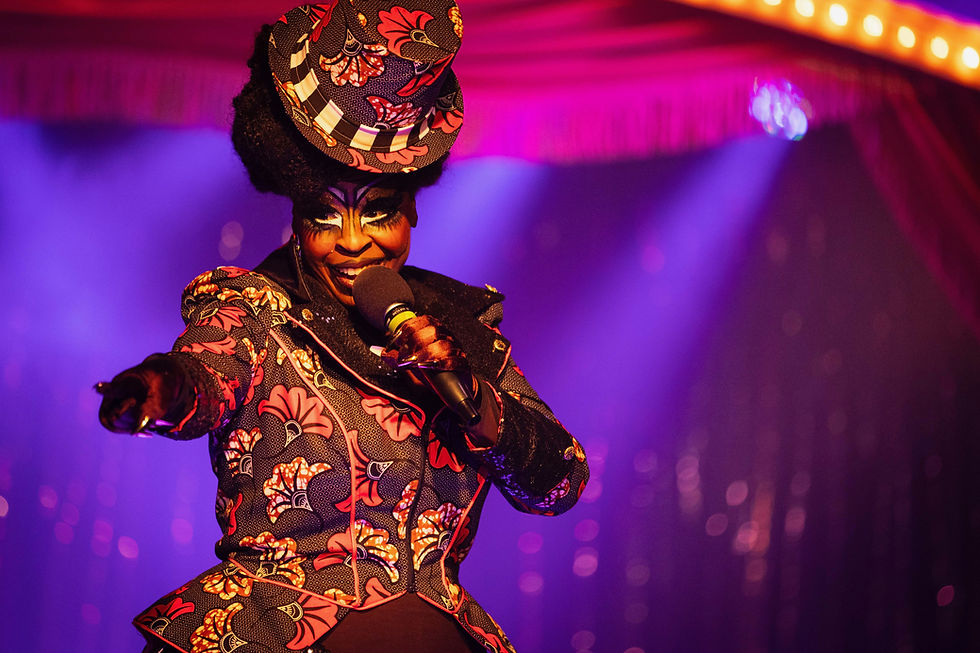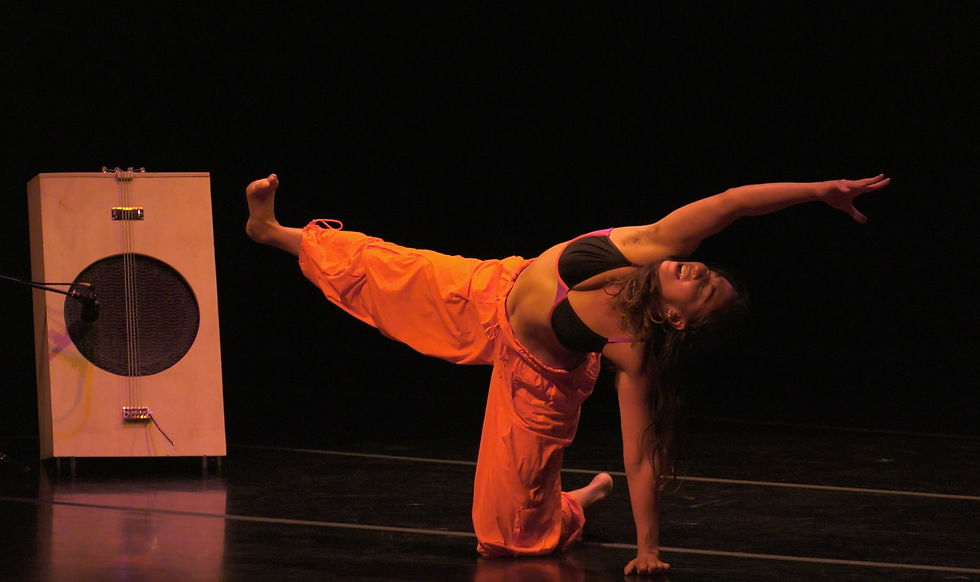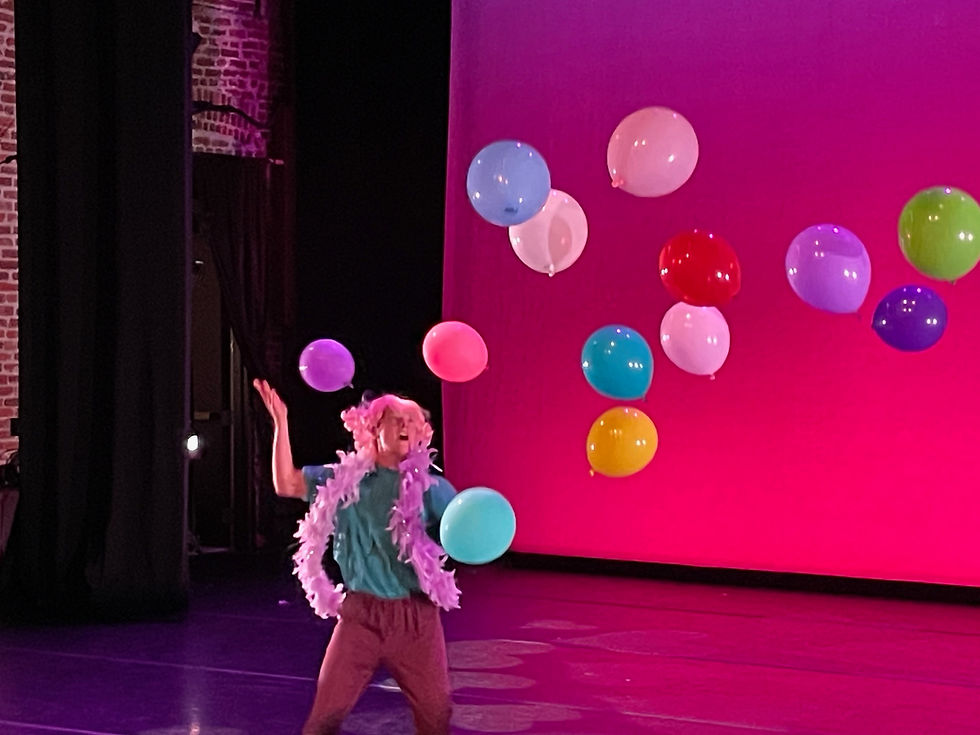Review: ODC Theater Presents State of Play 2025, ODC Theater & ODC Dance Commons, July 31 – August 3, 2025
- Jen Norris
- Aug 4
- 6 min read
ODC Theater’s annual State of Play (SOP) festival offers Bay Area a snapshot of the contemporary performance field. Arriving in the doldrums of summer, during the most repugnant of times, as Gazans starve while powerful nations fail to act, as ICE raids rend families and communities, as the obsessive rehashing of a once distant sex-trafficking scandal fails to ever acknowledge the scores of female victims it retraumatizes with each rebroadcast, SOP25 is a much-needed shot of adrenalin.
To ensure fresh perspectives continue to be brought to the fore, ODC engages guest curators. Zaquia Mahler Salinas, a Chicanx/Palestinian dance artist “invested in movement-art as an act of reclamation and world building,” is the newest voice on the curatorial team, joining Chloë Zimberg (ODC Theater Creative Director) and Marya Kerr (ODC Resident Curator since 2023 SOP). One feels Salinas’s influence in the prevailing urgency of the presentations. Each of the 8 works in the festival bill explores self-identity and societal expectation, some are confrontational, many seek to provoke and upend the status quo. Presented with no-holds-barred commitment, even the piece which wasn’t my cup of tea provoked a strong, rather than a lack-luster, response. The perspectives of People Of Color, and LGBTQ artists are well-represented, as are those of women who lead and perform all the pieces, with the exception of a lone male, Jonancy Cruz Montero, who performs as part of single studio showing.
In her pre-curtain remarks, Zimberg reminds us of the political climate which finds already-too-scarce arts funding evaporating. Caught up in an ideological war to suppress the voices of artists across the United States, both individual performers and organizational presenters are being cast out. Yet one senses under the desperation, a freedom in having no funders to please, in being accountable only to one’s self, one’s collaborators, and one’s audience.
SOP25 festival format of compact 30-minute works, invites one to attend 3 or 4 works in an evening. Late afternoon Work-in-Progress showings in a sunlit studio yield to early evening presentations of more fully produced work in the theater, inviting us to participate in dance making along a spectrum of completion.
Even a staged-work, needs opportunities for development in front of an audience, as was the case with Black Benatar vs the Cistem, a drag-drama which puts the American medical system on trial for its failure to listen to, believe, diagnose, or effectively treat women, and most especially Black women. With puppetry, over-the-top costumes (think gold-sequin encrusted ovarian tube headdress), and clever monikers, Black Benatar personifies the cysts (Cystina the Dismissed Cyst), ovaries (twins Ova & Ries) and fibroids (husky-voiced members of the Phi-B-Ro fraternity) who provide witness testimony for us, the jury. As the facts emerge, we learn how the doctors’ ongoing dismissal of their patient’s escalating symptoms during fertility treatments, lead to a hysterectomy rather than a baby. While the script is uneven, the potential for this work is great. The soft-sculpture artistry of the costumes and puppets, and the pitch-perfect design of the character silhouettes projected behind the proceedings, lay the groundwork for a truly fabulous show in some future cabaret-style presentation.

State of Play grew out of ODC’s Walking Distance Dance Festival, in which work was presented in a variety of venue types and sizes and audiences walked between them. The ODC Theater is a beautiful venue for concert dance, but several of the SOP25 works would have benefited from smaller, more intimate spaces, Black Benatar and Deepe Darknesse among them.
Lisa Fagan and Lena Engelstein’s Deepe Darknesse opens with Fagan unfurling a huge role of bubble-wrap down the stairs which abut audience seating. Navigating the stairs, now a minefield of bubbles which pop with each footfall, her elastic facial tics move from startled, to mischievous, to outrageously defiant. As Fagan relishes our attention, the echo of a second set of pops develops across the stage. Her partner in crime, Engelstein, transits along her own plastic packing-sheet path.
Reveling in the breaking of boundaries and abandonment of propriety and performance norms, the two performers egg each other on. They breath heavily into microphones, take audible pee-breaks, repeatedly call for lines of dialogue. Changing clothes and having makeup applied mid-performance, in the blinding light of a make-up person’s headlamp, synchronized duets of non-sensical dance phrases interrupt the bedlam, providing glimpses of the many genres of concert dance in which the duo is highly-skilled. Unfortunately, rather than feeling wild and unpredictable, the piece feels overworked and flat, like when a kid forces you to repeatedly tell the same joke hoping for the delight of the first telling. A sequence in which the gals stop to take notes on the evening’s show felt fresher, as it allows for true improvisation. Placing the audience in seats surrounding the stage may have helped enliven this one, for audience and performers alike.

For Wanjiru Kamuyu’s tour de force solo, An Immigrant’s Story, the stage is edged by upturned chairs. Their jutting metal legs create inhospitable borders within which her tales of migration unfold. Sections of contemporary dance are interspersed with spoken narratives. Costume changes, from contemporary African print blouse and Adidas pants, to a ragged colonial-era slave dress, signal our heroine’s arrival on a new shore where fresh societal obstacles await. Later the dress, now worn backwards mimics a high-necked straightjacket in which Kamuyu seems forced to dance. A charismatic mover, Kamuyu’s anguish speaks as forcefully in the danced sections as does her recounting of the bullying with which she is welcomed to Michigan by an African American female classmate, whom some might expect to be an ally. Kamuyu is a sophisticated citizen of the world, and we root for her success, enjoying the finale when African drumming morphs into a disco beat and Kamuyu in colorful headwrap and form-fitting tank-top dances with clubby abandon, displaying an innate buoyancy which has no doubt helped her ride the waves of each new culture.

FISHBLOD, a solo, created and performed by gizeh muñiz is the most visceral of dances. As the audience enters, an anonymous hooded figure, bent at the waist, hangs suspended high above the stage, with arm splayed across a tether shooting out to the sidewall. As the figure begins to slowly thaw, barely perceptible movement grows into taut, hand-over-hand pulling, drawing the body away from the stasis and closer to the wall. When the effort finally becomes unsustainable muñiz lets go, severing a connection which kept the sound and lighting working, their limp body swing pendulum-like in the darkness.
Lowering her harness closer to the ground, muñiz dangles, writhing as a dying fish on a rope. With spastic pushes of feet, elbows, and knees she waggles out of the harness and begins a fascinating wilting locomotive sequence. Twisting, flopping, and rolling her whole body in unpredictable ways, she rises to buckling ankles and collapses once more. Upside down, hooded-head ducked, they creeps ass-up on shoulder blades and the balls of her feet, face continually obscured. A master of pacing, muñiz deploys stillness as effectively as she does the whipping windmilling of arms. Able to control every muscle in their body, muñiz makes captivating the smallest of movements, drawing us in to an interplay between her newly naked toes.

shuhada alive-streamed un-ceased FIRE, created by Beirut-based choreographer Alexandre Paulkevitch, in collaboration with solo performer Leila Awadallah, addresses the tropes of the Arab, feminine body. Performing topless, in loose harem pants, Awadallah speaks candidly to the audience of the war in Gaza and our complicity. Her hips move in easy figure-8’s flowing like an unconscious belly dance. She is beguiling and likeable. Awadallah shares the stage with a persistent buzzing machine, whose discordance and volume grows over the course of the 30-minute piece. Plucking its strings, she provokes ear-splitting tones, which overtake her monologue. As if in answer to a self-inflicted query, “What dance can be made and performed during a genocide?”, Awadallah’s movement becomes frantic, unpredictable, and violent. She dances to exhaustion disappearing into darkness, never to return, as the lights rise on an empty stage, sans curtain call.

Love never goes out of style, and a bit of laughter is good for our souls, which is no doubt why the curatorial team invited Molly Rose-Williams to adapt her evening-length CRUSH into a succinct and laughter-filled half-hour of physical comedy and emotional truths. No one more embodies the irresistible thrill and anxious agony of having a crush then Rose-Williams. Whether mugging her way through a first meeting, or avoiding an awkward silence, after confessing her affection, with a raucous tumbling pass and frantic crawling, we revel in her unique physicality, vulnerability and willingness to play the fool.

Promising work-in-progress showings, komainu duet by New York-based Kimie Parker exploring her Japanese heritage, and Maya, by Bay Area artist Kira Fargas, a quartet fusing contemporary dance with snippets of Philippine folk dance, complete the 8-shows of State of Play 2025. Members of the Bay Area dance community comprise a substantial portion of the SOP audience, speaking volumes to the importance of this program to the local artistic ecosystem. Fingers crossed that funders step forward to ensure the Festival’s longevity.
Review by Jen Norris, published May 12, 2025
________________________
Link to digital program book





Comments